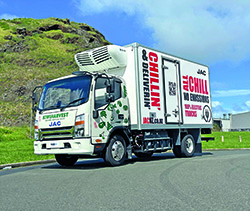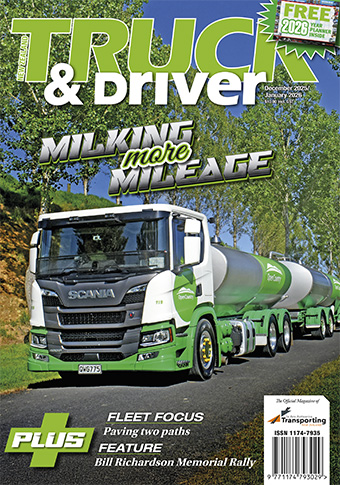
Town and around
Posted: 27-Mar-2025 |
Battery electric heavy commercial vehicle registrations are up significantly this year with 169 units being registered in the first nine months of 2024. It’s a notable increase from 107 units across the full-year in 2023, although the majority of the volume is represented by larger vans and city buses.
For trucks, the momentum is expected to build following the recent announcement of the Government’s Low Emission Heavy Vehicle Fund which is administered by EECA. The initiative establishes $27 million in assistance to transport operators which can fund up to 25% of the purchase cost of eligible heavy vehicles.
Among those eligible vehicles is the China-sourced JAC line-up of N Series EV trucks available in N60, N75 and N90 variants. The brand and the EV line-up were launched in New Zealand in late-March, with 10 sales locations at existing Colonial Motor Company operations and supported by the Southpac Trucks network for servicing.
Since the EV launch JAC has followed up with Cummins powered diesel versions on the N Series and is about to launch into the light commercial sector with the ruggedly styled T9 Ute.
For the New Zealand market the JAC EV trucks are available in three wheelbase choices and GVMs from 6.0t up to 9.0t, offering multiple configurations to suit different business needs.
The brand might be a recent arrival in New Zealand but JAC has been a vehicle manufacturer in China for 60 years. And further afield the JAC EV is already proven with many well-known international fleets including DHL, Heineken, PepsiCo, Carrefour, KraftHeinz, Crown Relocations, and Kerry Logistics.
Key specifications include the use of CATL-produced lithium iron-phosphate battery packs with 107kWh capacity and two EV drivetrain options offering 130kW and 171kW outputs with a two-speed gearbox. The 171kW motor is reserved for the 9t GVM models which carry N90 designation.
Three wheelbase options – 3365mm, 3845mm and 4475mm – are being offered in flat deck and bare cab/chassis configuration, while `turn-key’ box body and tipper body options are being developed for popular applications.
One of the interesting aspects of the JAC launch has been advertised list prices, something common in the passenger and light commercial (ute and van) segments but much less common in larger commercial vehicles.
So the N60 EV tested here has an RRP of $148,990. It’s certainly more expensive than a diesel equivalent but with running cost advantages including no RUCs to pay till after December 31, 2025. There is an online calculator on the JAC NZ website for customers to estimate the savings they’ll achieve.
Other benefits include a full roster of active safety and driver assist systems. These include Autonomous Emergency Braking, Lane Departure Warning System, Electronic Stability Control, and Hill Start Assist. There are two airbags, parking sensors, and a reversing camera.
New Zealand Truck & Driver got to test this truck in a predictable blend of alternating Auckland springtime sunshine and rain, and certainly in what you could call typical Auckland traffic.
It’s nothing like the more adventurous locations we prefer for our big truck tests, but it’s easy to imagine the N Series will find the vast majority of its work doing short haul city transport.
In fact, this particular truck is about to start work at Kiwi Harvest and will be used for chilled food distribution around the Auckland region.
Sitting in the cab you get a real sense of what the truck is designed for. The seats are comfortable and well suited to spending most of the day in the cab. It’s easy to get in and out of the cab, which is what most drivers will be doing each day.
The wide windscreen offers plenty of all round visibility for urban running and busy traffic while the mirrors are well positioned. It’s clear that JAC have understood the truck will predominantly be driven in busy city traffic and will need to work in some tight spaces.
Once up and running the steering feels nicely weighted and makes light work of the bustling industrial sprawl of Wiri and Highbrook, along with a short stint on the Southern Motorway.
An 8.0-inch touchscreen entertainment unit is centrally positioned on the dash and is a bit of a reach from the drivers position. The steering wheel provides the driver with access to the cruise control and driver assist features.
But the important question with any EV is how far will it go and how long will it take to charge?
JAC has selected a battery size that is suited to about 200km of city running based on JAC NZ’s own city testing when fully loaded, which also means recharging from 20-80% State of Charge (SOC) in only 48mins using a 120kW DC fast charger.
We began our journey with the energy display indicating 71% battery charge and 130km of range available. We clocked up 42.5km around the city leaving the battery at 54% charge and an indicated 106km of range – so the N60 had initially been a little pessimistic about its capability and was gradually stretching out its available range.
It’s important to note that when we test these trucks we do things a little different to a normal days driving as we have to stop and start a lot for photos and note taking.
When you have driven a couple of modern EVs there are no real surprises when it comes to driving technique, other than the obvious conscious effort at making efficient use of the high torque and minimising the braking and to gain the most benefit from regeneration. In the JAC N60 EV the regenerative braking can be maximised by selecting the Economy drive mode.
One aspect of driving EVs is the quietness of the powertrain seems to push other noises to your attention. We noticed a slight whirring sound when travelling under 20kph and there was a rubbing noise coming from what seemed like the back of the passenger seat.
That could speak to the overall quietness and refinement inside the cab bringing those sounds into focus.
For companies looking to begin their move into EVs the JAC N series offers efficiency and adaptability while meeting the expectations of a vehicle designed for operation in a busy city environment.
An important part of the appeal will be the 5-year and 200,000km warranty cover while JAC offers multiple body fitment options designed with the New Zealand market and in mind.
And finally, the N60 6.0t version with the 3365mm wheelbase can be driven on a Class 1 driving license, providing a little more versatility to fit into a business which is looking to meet its sustainability targets.



 + EQUIPMENT GUIDE - FREE
+ EQUIPMENT GUIDE - FREE
